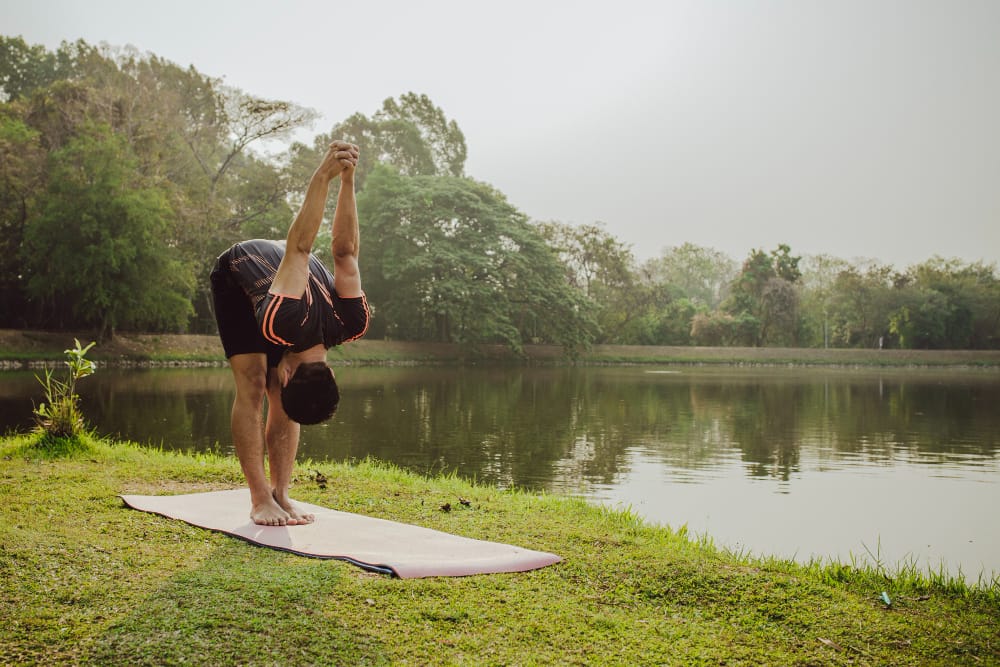Table of Contents
Introduction: Why Yoga for Digital Detox Matters
In today’s fast-paced digital world, technology has become a constant companion. From smartphones and laptops to televisions and tablets, we are surrounded by screens almost every moment of the day. While technology offers many conveniences, overexposure can lead to digital fatigue, eye strain, poor posture, anxiety, and disrupted sleep cycles. Spending too much time online can also disconnect us from the real world, our bodies, and even from ourselves.
Yoga for Digital Detox is an excellent way to take a healthy break from screens and reconnect with our mind and body. It offers an opportunity to pause, refresh, and reduce the mental clutter caused by constant notifications, social media scrolling, and information overload. In this blog, we will explore why a digital detox is essential and how practicing specific yoga poses and mindful techniques can help you unplug from technology in a healthy and enjoyable way.

What is Yoga for Digital Detox?
Yoga for Digital Detox refers to the combination of yoga postures, breathing exercises, and mindful habits designed to help you step away from digital devices and recharge naturally. Unlike regular yoga sessions that focus mainly on flexibility and strength, this type of yoga prioritizes relaxation, mental clarity, and mindfulness.
When you practice Yoga for Digital Detox, you consciously create moments of digital silence to restore your mental focus and emotional balance. It helps you become aware of how much time you spend online and teaches you how to set healthy boundaries with technology.
Why You Need Yoga for Digital Detox
1. Break the Cycle of Constant Connectivity
Being connected all the time can lead to addiction, anxiety, and even depression. Yoga for Digital Detox provides a structured way to pause and step back from the digital world.
2. Improve Posture and Physical Health
Many people experience neck pain, backache, and stiffness due to prolonged screen use. Practicing yoga can correct your posture and relieve physical tension caused by sitting for long hours.
3. Boost Mental Clarity
Digital clutter reduces our attention span and makes it harder to focus. Yoga for Digital Detox helps clear mental fog and improves concentration.
4. Reduce Stress and Anxiety
Constant notifications and social media pressure can trigger stress. Yoga’s mindful breathing and slow movements calm the nervous system and promote relaxation.
5. Improve Sleep Quality
Too much screen time, especially before bed, disrupts sleep patterns. Regular yoga practice helps relax the body and mind, promoting deeper and better sleep.
Yoga for Digital Detox: Key Poses to Unplug
Here are some easy and effective yoga poses you can practice as part of your Yoga for Digital Detox routine. These poses are gentle, beginner-friendly, and suitable for people of all ages.
1. Child’s Pose (Balasana)
Child’s Pose is a deeply relaxing posture that helps release tension from the back, shoulders, and neck.
How to do it:
- Kneel on your yoga mat and sit back on your heels.
- Slowly fold forward, bringing your forehead to the mat.
- Extend your arms forward or let them rest by your sides.
- Breathe deeply and hold for 1-3 minutes.
Benefits: Relaxes the mind, relieves tension, and stretches the spine.
2. Cat-Cow Pose (Marjaryasana-Bitilasana)
This sequence gently warms up the spine and helps release stiffness caused by sitting for long periods.
How to do it:
- Start on your hands and knees in a tabletop position.
- Inhale, arch your back, and lift your head (Cow Pose).
- Exhale, round your spine, and tuck your chin (Cat Pose).
- Repeat slowly for 1-2 minutes.
Benefits: Improves flexibility, corrects posture, and relaxes neck and shoulder muscles.
3. Standing Forward Bend (Uttanasana)
This calming pose stretches the hamstrings and releases tension from the back.
How to do it:
- Stand tall and slowly bend forward from your hips.
- Let your head and arms hang freely.
- Hold your elbows with opposite hands if comfortable.
- Breathe deeply for 1-2 minutes.
Benefits: Relieves stress, calms the mind, and stretches the spine.
4. Legs Up the Wall (Viparita Karani)
This pose helps improve blood flow and relax tired legs, especially after sitting all day.
How to do it:
- Lie down near a wall and lift your legs up to rest against it.
- Keep your arms relaxed by your sides, palms facing up.
- Stay in this position for 5-10 minutes.
Benefits: Reduces anxiety, improves circulation, and promotes relaxation.
5. Seated Neck Stretch
This simple stretch is essential for relieving neck and shoulder tension from screen time.
How to do it:
- Sit comfortably with your back straight.
- Gently tilt your head to one side, bringing your ear toward your shoulder.
- Hold for 30 seconds and switch sides.
Benefits: Reduces neck stiffness and improves flexibility.
6. Corpse Pose (Savasana)
This final resting pose allows your body to fully absorb the benefits of your practice.
How to do it:
- Lie flat on your back with your arms and legs relaxed.
- Close your eyes and breathe naturally.
- Stay in this pose for 5-10 minutes.
Benefits: Deep relaxation and complete mental reset.
Mindfulness Practices for Digital Detox
Practicing Yoga for Digital Detox can be even more powerful when combined with mindful habits that help you manage your screen time better.
1. Set Screen-Free Times
Create specific times in your day when you avoid using digital devices. Good options include early mornings, mealtimes, and at least one hour before bedtime.
2. Breath Awareness Exercises
Taking just a few minutes to focus on your breath can instantly calm your mind. Try deep belly breathing or counting your breaths to reduce digital stress.
3. Walking Without Devices
Go for a short walk in nature or around your neighborhood without your phone. Focus on the sounds, colors, and scents around you.
4. Yoga Journaling
Write down your experiences with Yoga for Digital Detox in a journal. Track how you feel before and after your sessions. This helps you stay consistent and notice your progress.
5. Create a Calm Space
Set up a small space in your home where you can practice yoga and meditation without distractions. Keep it simple, clean, and peaceful.
6. Mindful Eating
Practice eating meals without screens. Focus on the taste, smell, and texture of your food. This simple habit improves digestion and helps you become more present.
Building a Daily Yoga for Digital Detox Routine
Here is a simple sample routine you can follow daily:
Morning (10-15 Minutes)
- Cat-Cow Pose: 2 minutes
- Standing Forward Bend: 2 minutes
- Breath Awareness: 2 minutes
Mid-Day Break (5-10 Minutes)
- Seated Neck Stretch: 2 minutes
- Child’s Pose: 3 minutes
Evening (15-20 Minutes)
- Legs Up the Wall: 5-10 minutes
- Corpse Pose: 5-10 minutes
Add journaling or a mindful walk for extra digital detox benefits.
Long-Term Benefits of Yoga for Digital Detox
When you practice Yoga for Digital Detox regularly, you can expect several long-term benefits, including:
- Better Focus: Improved attention span and mental clarity.
- Healthier Posture: Reduced back, neck, and shoulder pain.
- Lower Stress Levels: Better management of anxiety and stress triggers.
- Improved Sleep: Deeper and more restful sleep cycles.
- More Balance: A healthier relationship with technology and social media.
Conclusion: Embrace Yoga for Digital Detox in Your Life
Technology is here to stay, but we can control how much we depend on it. Yoga for Digital Detox is a simple and effective way to take back that control. It helps you create healthier habits, feel more connected to yourself, and experience real moments away from screens.
You don’t have to completely give up technology. Start small, practice consistently, and you will soon notice positive changes in your body, mind, and lifestyle. Make Yoga for Digital Detox a part of your daily life, and you will enjoy a more peaceful, balanced, and present way of living.
FAQs about Yoga for Digital Detox
1. How often should I practice Yoga for Digital Detox?
Aim for at least 3-4 sessions per week. Daily short practices can offer faster and better results.
2. Can beginners try Yoga for Digital Detox?
Yes, all the poses and techniques mentioned here are beginner-friendly and safe for all age groups.
3. Do I need special equipment for Yoga for Digital Detox?
No special equipment is needed. A yoga mat or a soft surface is enough to start.
4. How long should each yoga session be?
Start with 15-20 minutes per session and adjust based on your comfort and schedule.
5. Can Yoga for Digital Detox improve my productivity?
Yes, reducing digital overload through yoga can sharpen your focus, reduce distractions, and increase productivity.

